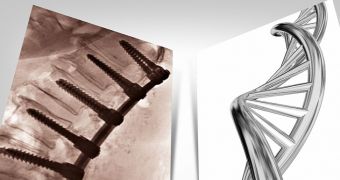There have been a few 3D printed implants, but for the most part, when it comes to surgery and medicine as a whole, 3D printing is mostly used to create models of injuries, for better surgery planning and explanations to patients.
A French surgeon from Lyon, however, decided to make the leap and use 3D printed components in a spinal-fusion surgery, thus correcting some severe spinal deformities suffered by one of his patients.
Spinal fusion surgery is employed when someone experiences pain from abnormal vertebrae motions caused by degenerative diseases. Essentially, the faulty vertebrae are fused together.
Scoliosis and kyposis are treated in a similar manner as well, from time to time, when braces fail. Now, 3D printing technology has shown its usefulness in achieving this goal.
The French surgeon we've mentioned used an intersomatic cage that mimicked the anatomic details of the patient's vertebral plates. A company called Medicrea designed and printed the cage, pulling on its vast expertise in design, development, manufacture and distribution of orthopedic implants.
The cage positioned itself automatically in the natural space between the vertebrae, molding itself just right with the spine and jointing with the end plates, something normally hard to pull off due to irregularity and asymmetry.
3D images of the patient's spine were used to create the special cage, while Dr. Fiere used Surgimap Spine (a tool also created by Medicrea) to plan the intervention itself.
Thanks to the practice he got several days before the operation, the doctor was able to restore the disc height and correct the degree of lumbar lordosis (the inward curvature of the lumbar region of the spine).
3D printing technology is changing the lives of many people who had previously been facing a lifetime of immobility or pain. So far, we've seen 3D printed titanium hip implants, a skull implant, a full skull replacement (you've got to love 3D bioprinting), 3D printed substitutes for shoulder blades, etc.
There are still risks that the body of the recipient will reject the implants, of course, but there are risks every time a surgeon has to make a cut into someone while seeking to save their life or restore their livelihood.
No doubt we will keep hearing about more and more medicinal/surgical applications of 3D printing technology over the following months, until such techniques become commonplace in this field, years down the line. Even afterwards, the benefits should remain quite visible.

 14 DAY TRIAL //
14 DAY TRIAL //